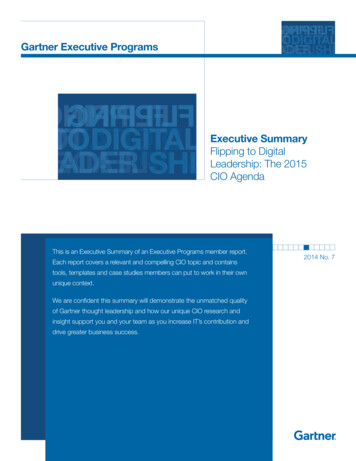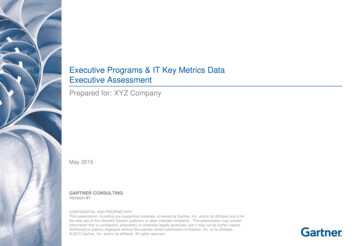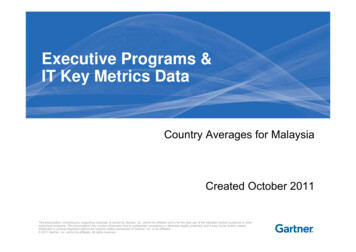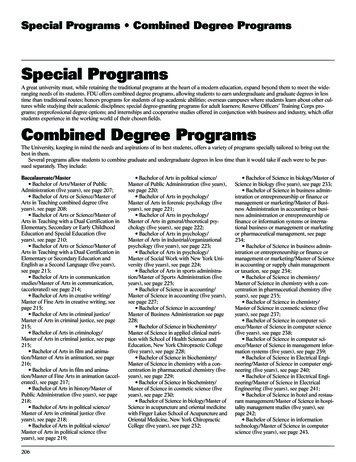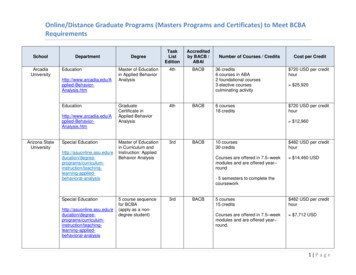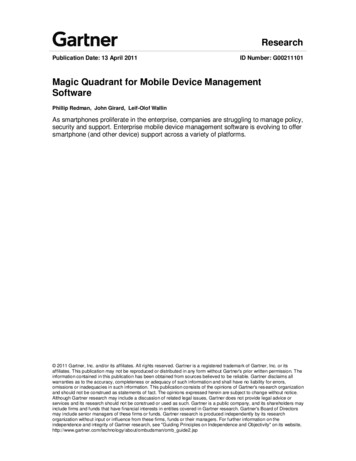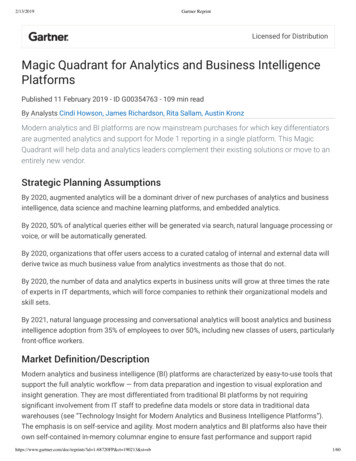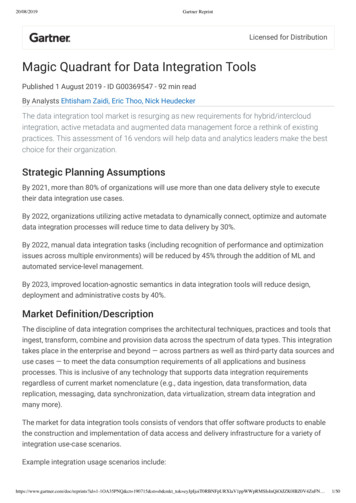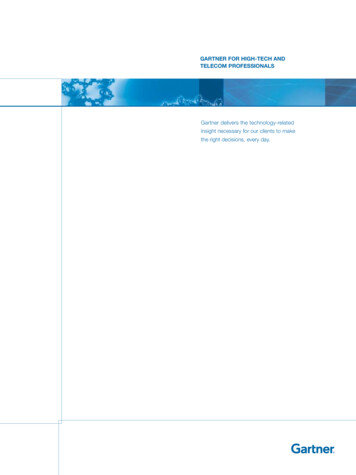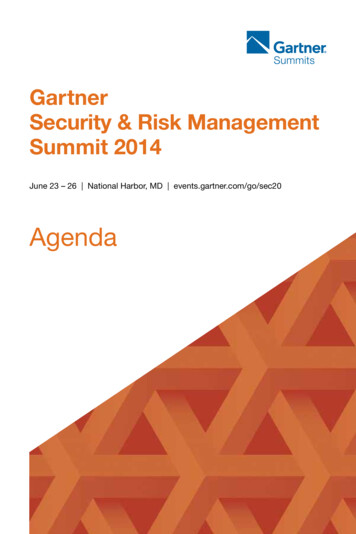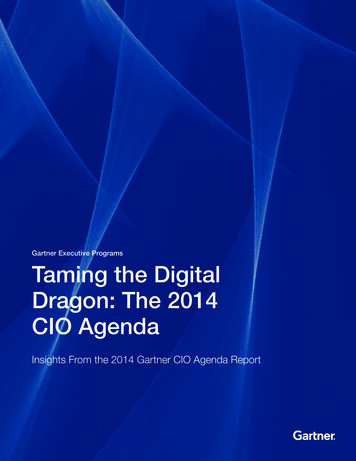
Transcription
Gartner Executive ProgramsTaming the DigitalDragon: The 2014CIO AgendaInsights From the 2014 Gartner CIO Agenda Report
About the Gartner CIO Agenda ReportThe annual Gartner CIO Agenda Report is informed bythe world’s largest annual CIO survey, which for the past13 years has tracked how CIOs balance their business,strategic, technical and management priorities. Thereport comprises survey findings, case studies, expertanalysis and actionable insight, enabling CIOs to comparetheir strategies and activities with the priorities andactions of their global peers, and get a glimpse intowhat the future may hold. The survey findings in theirentirety form the foundation of the annual ExecutivePrograms CIO research agenda.This year’s survey encompasses the views of 2,339CIOs across 77 countries, representing more than 300 billion in corporate and public-sector IT spending.Here are some of the key insights from this year’s report.Visit gartner.com/cioagenda
IT in 2014: Facing a torrent of digital opportunities andthreatsAll industries in all geographies are being radically reshapedby digital disruption — a “digital dragon” that is potentiallyvery powerful if tamed but a destructive force if not. It’s aCIO’s dream come true, and also a career-changingleadership challenge.In reporting their top technology priorities for 2014, this year’s CIO survey respondents revealtwo complementary goals: Responding to ongoing needs for efficiency and growth by renovating the core of IT S hifting to exploit a fundamentally different, digital paradigm, including new technologiesand trendsCurrent enterprise IT is not set up to easily deliver on the second goal. Fifty-one percent ofCIOs are concerned that the digital torrent is coming faster than they can cope, and 42%don’t feel they have the right skills and capabilities in place to face this future.Visit gartner.com/cioagendaGartner Executive Programs1
Entering the third era of enterprise ITY2K and the dot-com bust brought the first, “mad inventor” era of enterprise IT to a closeand ushered in the second — an “industrialization” era of processes, services, standards andsmart sourcing, making IT more reliable and professional, open and transparent, and treatingthe rest of the business as its internal customers.CIOs now face the challenge of straddling the second era of enterprise IT and a new, third“digitalization” era — moving from running IT like a business within a business, into a periodcharacterized by deep innovation beyond process optimization, exploitation of a broaderuniverse of digital technology and information, more-integrated business and IT innovation,and a need for much faster and more agile capability.We are hereIT craftsmanshipIT reateEngageTechnologyProcessesBusiness modelsCapabilitiesProgramming,systems managementIT management,service managementDigital leadershipEngagementIsolated; disengagedinternally and externallyTreat colleagues ascustomers; unengagedwith external customersTreat colleaguesas partners; engagedwith external customersOutputs andoutcomesSporadic automation andinnovation; frequent issuesServices and solutions;efficiency and effectivenessDigital business innovation;new types of valueFocus2IdeateGartner Executive ProgramsVisit gartner.com/cioagenda
Business leaders want growth and innovation, butbudgets are up only slightlyIn terms of management’s mood, CIOs report a gradual but undeniable shift toward 4Note: Percentages for each year maynot add up to 100% due to rounding.0%But despite the need to grow, there is pressure on budgets. The global weighted averageexpected change in CIO IT budgets is 0.2%. This lack of significant uptick presentschallenges for the CIO and IT organization since there is a need to simultaneously renovatethe core of IT systems and services, and exploit new technology options.CIOs also report that a quarter of 2014 IT spending will happen outside the IT budget. Andthat is the spending they know about; the reality may be significantly higher — a direct resultof the new digital opportunities that are more entwined with customer and colleagueexperiences.Visit gartner.com/cioagendaGartner Executive Programs3
Meeting the digital future demands a three-part responseIT as order taker is the wrong model for taming the digital dragon.Digital innovation will require IT to ideate, or dream the digital dream, and execute in closepartnership with colleagues, in an exploratory way, with understanding of the potential ofnew trends. Much of the innovation will come as major disruptions to the way we think aboutbusinesses. Processes will cease to be the whole story or even the main story.This year’s survey data and case study interviews show that leading businesses, governmentsand public-sector agencies are preparing for the digital future by innovating in three areas: Creating powerful digital leadership Renovating the core of IT Building bimodal capabilityIT industrializationDigitalization Clear digital roles Savvy digital executives Digital vision and digital legacyCreate powerfuldigital leadershipBuild bimodalcapabilityRenovatethe core Cloud/Web-scale infrastructure Information Talent Sourcing Agile development Multidisciplinary teams Innovative partnerships New risk/speed trade-offs4Gartner Executive ProgramsVisit gartner.com/cioagenda
Creating powerful digital leadershipTo exploit digital opportunities and ensure that core IT services are ready, CIOs must strive forclear digital leadership, strategy and governance; and help build a digitally savvy C-suite withproven approaches such as the use of digital nonexecutives, technology showcases,“hackathons,” reverse mentoring, and examples and analogies from other industries.Digital leadership is not a substitute for IT leadership; it’s more an adaptation of businessleadership to the digital context. Clarifying the coverage and scope of digital leadership, andintegration with IT leadership, should be high on every CIO’s 2014 agenda.There is a fast-rising trend to hire chief digital officers (CDOs). Originally a marketing andmedia officer, this role has broadened over the past year. Around 7% of enterprises have aCDO, and they are spread across all geographies and a wide variety of industries.IndustryNorth America5%EMEA6%Latin America7%APAC11%% rance9Retail9Healthcare providers5Government5Manufacturing/natural resources5Wholesale trade3Education3Transportation4Utilities1We predict a tripling of the prevalence of CDOs and similar roles in the next year.Visit gartner.com/cioagendaGartner Executive Programs5
Renovating the IT coreThe IT core — infrastructure, applications, information and sourcing — was built for theIT past. CIOs report much of their new technology spending going toward improving coresystems and capabilities.Needed renovations to ensure fit for purpose and being “digital ready” include moving to amore loosely coupled “postmodern-ERP” paradigm, deploying public and private clouds,creating the information architecture and capabilities to exploit big data, and augmentingconventional sourcing with more innovation, including sourcing from, and partnering with,smaller and less mature enterprises.Increased adoption andintegration of public andprivate IaaS, PaaS, SaaSand elocity/variety;in-memory databases;advanced analytics;unstructured and multimedia dataPostmodernERP/appsMore-federated ERP,multi-enterprise solutions,cloud components, mobilesupport, psUse of SMBs/startups;new categories of partner(e.g., mobile, design,analytics)CIOs have big concerns around the talent to execute on these renovations, especially when itcomes to agile skills such as digital design, data science, “digital anthropology,” SMB/startupengagement and agile development: 43% said improvements were needed, with 39% sayingIT could use a major talent overhaul.6Gartner Executive ProgramsVisit gartner.com/cioagenda
Building bimodal capability — Two-speed ITTo capture digital opportunities, CIOs must deal with speed, innovation and uncertainty. Thisincreasingly requires operating two modes of enterprise IT: conventional and “nonlinear.”The second era of enterprise IT has been about planning and doing IT right, being predictableand creating value, while maximizing control and minimizing risk. The third “digitalization” eraposes additional, nonlinear challenges, such as the need to: Absorb disruptive new business models, enabled by new digital technologies Scale up and down in Internet time React quickly to capture “business moments” Flex painlessly to support business model innovations Explore and evolve solutions that are surrounded by uncertaintyMeeting these needs with one speed of IT is impossible. Forty-five percent of this year’s CIOshave already built some agile software development capability into their grow-and-changefunction — using iterative and agile methodologies and tools, and typically involving very shortcycles and high levels of collaboration with users and sometimes external customers,throughout the life cycle.IT craftsmanshipIT industrializationCIOCIOOOCIOFunctional/process silosRunCIO CDOP&LownersOOCIO aryproduct teamsOOCIO office of the CIO, running IT as a business (strategy, governance, finance, security and risk, etc.)CTO chief technology officer, acting as chief operating officer of ITCDO chief digital officer, acting as digital change agentRun every aspect of IT needed to keep the business runningD demand management — internal demand/relationship/account managers facing off to other parts of the businessGrow/change every aspect of IT needed to execute on growth and changeVisit gartner.com/cioagendaGartner Executive Programs7
Required in 2014: The CIO’s bold visionA combination of powerful digital and societal forces — the digital dragon — hascreated much broader and deeper opportunities and threats than the scope oftraditional enterprise IT covers. CIOs need to act fast and smart to protect theircompanies, their public-sector agencies, their IT organizations and themselves.This is a fundamental change in the way information and technology show up in theenterprise — a rethinking of the role of the CIO and the IT organization, and the rest ofthe business’s expectations, getting unstuck, and shifting to the third era of enterpriseIT. And it needs to happen as the important work of delivering and improving existingenterprise IT continues.If the dragon isn’t tamed, businesses could fail and the relevance of the IT organization willalmost certainly disappear. If this transition succeeds, massive new value can be created,and with it, a renewed role and greater credibility for the CIO and the IT organization.8Gartner Executive ProgramsVisit gartner.com/cioagenda
Gartner Executive Programs: Membership leadsCIOs and their teams to successWith Gartner Executive Programs you can be certain you are making the bestpossible decisions for your enterprise. Backed by CIO experts who work withthousands of CIOs each year, members of Executive Programs receive specializedinsight, tools, benefits and concierge-level services that empower them and theirteams to drive greater business success.Extend your vision, achieve your goals.Make decisions with confidence, from significant technology selection andgovernance modeling, to advising your C-level peers about IT’s role in drivingcompetitive advantage. No CIO can do it alone. Benefit from Gartner insight deliveredin your context, the world’s largest community of CIOs, and unparalleled insight intothe CIO role.Deliver exceptional business results.Interact with subject matter experts who will equip you with proven methods, toolsand techniques for driving IT’s business contribution and communicating it throughyour team and to all levels of the organization, including the board of directors.Utilize our capabilities within the way you work.CIOs manage a full agenda, which is why your Gartner Executive Programsrelationship team designs an engagement plan specifically for your priorities. YourCIO expert maps our research and capabilities to your immediate and long-termobjectives and delivers value throughout your membership.Tap into the largest community of CIOs in the world.Reduce risk and save time by leveraging the insight and experience of other CIOswho have addressed similar problems and opportunities both inside and outsideyour industry.To learn more, contact your Gartner accountexecutive or visit gartner.com/cioagenda.
About GartnerGartner, Inc. (NYSE: IT) is the world’s leading information technology research and advisorycompany. We deliver the technology-related insight necessary for our clients to make theright decisions, every day. From CIOs and senior IT leaders in corporations and governmentagencies, to business leaders in high-tech and telecom enterprises and professional servicesfirms, to technology investors, we are the valuable partner to clients in over 13,000 distinctorganizations. Through the resources of Gartner Research, Gartner Executive Programs,Gartner Consulting and Gartner Events, we work with every client to research, analyze andinterpret the business of IT within the context of their individual role. Founded in 1979, Gartneris headquartered in Stamford, Connecticut, USA, and has 5,800 associates, including morethan 1,450 research analysts and consultants, and clients in 85 countries.Visit gartner.com/cioagenda. 2014 Gartner, Inc. and/or its affiliates. All rights reserved. Gartner is a registered trademark of Gartner, Inc. or its affiliates.For more information, email info@gartner.com or visit gartner.com. Produced by Marketing Communications EPGITECIOXBROC011514
Gartner Executive Programs: Membership leads CIOs and their teams to success With Gartner Executive Programs you can be certain you are making the best possible decisions for your enterprise. Backed by CIO experts who work with thousands of CIOs each year, members of Executive Programs receive specialized
